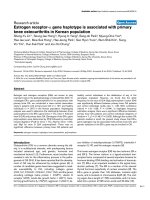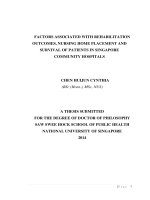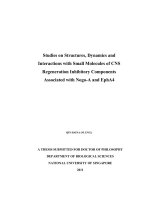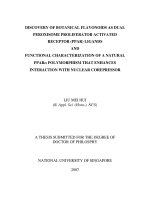Characterization of cultivable bacteria associated with larval gut of field caught population of diamondback moth, Plutella Xylostella (Linnaeus)
Bạn đang xem bản rút gọn của tài liệu. Xem và tải ngay bản đầy đủ của tài liệu tại đây (363.42 KB, 9 trang )
Int.J.Curr.Microbiol.App.Sci (2019) 8(3): 1880-1888
International Journal of Current Microbiology and Applied Sciences
ISSN: 2319-7706 Volume 8 Number 03 (2019)
Journal homepage:
Original Research Article
/>
Characterization of Cultivable Bacteria Associated with Larval Gut of Field
caught Population of Diamondback Moth, Plutella xylostella (Linnaeus)
W. Vijaykumar1*, R. Muthuraju1, B. Shivanna2, P. Shriniketan,
K.V. Vikram and K.S. Sruthy
1
Department of Agricultural Microbiology, 2Department of Agricultural Entomology,
University of Agricultural Sciences, Bengaluru-560065, India
*Corresponding author
ABSTRACT
Keywords
Diamondback moth
(DBM), Gut
bacteria,
Morphology,
Biochemical tests,
16S rRNA
Article Info
Accepted:
15 January 2019
Available Online:
10 February 2019
The cole crops like cabbage, cauliflower, broccoli and brussel sprouts etc. are most
important vegetables consumed all over the world, among them cabbage and cauliflower
are economically vegetables in India. Most of the cruciferous vegetables are vulnerable to
many insect pests. The Diamondback moth (DBM), Plutella xylostella Lineaus is the most
serious pest in causing economic loss. DBM developed resistant to almost all the synthetic
insecticides. Here we collected DBM population from Field of Rattihalli, Haveri district of
the state Karnataka, India and reared for one generation. Isolation of cultivable gut bacteria
was done from larvae of DBM using agar media and characterized each strain. Some of the
strains were gram positive and some were gram negative. Isolate 3 was shown positive
result and Isolate 10 was shown negative result for all biochemical tests (IMViC and
Catalase). Bacterial genomic DNA were isolated and amplified in PCR with 16S rRNA
primers (expected size 1000bp). Eight different bacterial isolates were obtained and
identified at genus level such as Pseudomonas otitidis, Dyella japonica, Bacillus sp.
Aneurinibacillus aneurinilyticus, Ralstonia solanacearum, Brachybacteria sp., Ralstonia
picketti and Kocuria turfanensis. These studies suggest that there were bacterial diversity
in DBM and these bacteria helps in development of P. xylostella.
Introduction
In vegetable production, India is now second
largest producer in the world after China with
estimated production of about 181 MT during
2017-18 from an area of more than 9.57
million hectares (Third Adv. Est. for Hort.
crops). India ranks second in respect of area
under cabbage cultivation (400.138 ha) at
world level but in respect of productivity it
ranks tenth (22.6 MT/ha). One of the serious
constraints to the successful production of
these crops is ravages of insect pests,
especially diamondback moth, Plutella
xylostella (Lim et al., 1997). Among the
winter vegetables, the cabbage (Brassica
oleracea var. capitata Linn.) is extensively
cultivated crop because of its nutritional and
economical values. It is attacked by a number
of insect pests. Diamondback moth (P.
xylostella L) is the most destructive insect
pest and is the major limiting factor for
successful cultivation of cruciferous crops
resulting in loss of quality and production. P.
1880
Int.J.Curr.Microbiol.App.Sci (2019) 8(3): 1880-1888
xylostella has national importance on cabbage
as it causes 50-80% annual loss in the
marketable yield (Devjani and Singh, 1999).
Frequent use of chemical insecticides at
higher doses results in depredation of natural
enemies and development of insecticide
resistance in P. xylostella against a wide
range of insecticides in different parts of India
(Talekar et al., 1990).
Enterococcus gallinarum, Brevundimonas
diminuta,
Enterococcus
faecium,
Staphylococcus
sp.,
Pseudomonas
aeruginosa, Acinetobacter calcoaceticus,
Bacillus subtilis, Rhodococcus sp. from the
gut of field collected H. armigera larvae. The
production of chitinase by gut bacteria from
DBM appeared to contribute to host nutrition
(Indiragandhi et al., 2007).V
The field that has received less attention is the
roles that microbes play in protecting insects
from toxic plant compounds and insecticides.
This is despite the fact that it is known that
many microorganisms contain enzymatic
degradation mechanisms for a variety of plant
secondary metabolites such as terpenes
(Marrmulla and Harder, 2014), nicotine and
cocaine (Brandsch, 2006) and even
phosphorus- or sulfer-containing insecticides
(Kerteszet al., 1994). Oftentimes the
interaction between microbe and insect are
difficult to disentangle, and the relative
contribution of insect versus microbial
defence mechanism is not yet known. The
molecular characterization and identification
techniques have improved the analysis of
diverse microbial populations (Muyzeret al.,
1993).
Materials and Methods
Studies on lepidopteran gut microbiota
suggested that microorganisms provide
essential nutrients and play a role in host
digestion (Broderick et al., 2004). Priya et al.,
(2012) isolated and identified Bacillus
niabense,
Paenibacillus
jamilae,
Cellulomonas
variformis,
Acinetobacter
schidleri,
Micrococcus
yunnanesis,
Enterobacter
sp
and
Enterococcus
cassilifavus from Helicoverpa armigera.
Ramesh et al., (2009) characterized gram
negative microbes Escherichia coli, Yersinia
enterocolitica, Klebsiella, Pneumonia sp.
from the gut of silk worm. Madhusudan et al.,
(2011) isolated Stenotrophomonas sp.,
Enterococcus casseliflavus, Enterococcus sp.,
The third instar larvae of DBM were starved
for 24 hours and surface sterilized with 70%
ethanol for 1 minute followed by 0.1%
sodium hypochlorite for 1 minute, then rinsed
with sterile distilled water for 2 to 3 times to
remove the external microflora. The
homogenized larvae were crushed using
pestle and mortar with 1 ml PBS solution (pH
7.4). The homogenized samples were
centrifuged at 2000 rpm for 10 minutes. Serial
dilution of samples was made up to 10-6
dilutions. The aliquot of 1 ml of 4-6 fold
dilutions were plated on media i.e. Nutrient
Agar (NA) and Luria Bertani (LB) agar. 100
µl of the suspension was inoculated on plates
containing media with three replicates. The
Sample collection and rearing
The different life stages of DBM such as
larvae, pupae and adults were collected from
the field of Rattihalli, Haveri district
(14.42°N, 75.51°E) of the state Karnataka,
India. In this region, most of the insecticides
were used to control this pest but it got
resistance to all this insecticides and this
region is cabbage growing region of south
Karnataka. The populations were reared on
mustard (Brassica juncia L.) seedlings in
plastic cups containing moistened vermiculite.
The individual cups were placed in rearing
cages for adult emergence.
Isolation of cultivable bacteria
1881
Int.J.Curr.Microbiol.App.Sci (2019) 8(3): 1880-1888
plates were incubated at 28°C for 48 hours.
After every 24 hours, plates were observed
for microbial growth. Based on morphology,
selected the colonies and made pure culture.
Purification of colonies was done by
following quadrant streak plate method. The
isolated pure colonies were streaked on NA
and LB agar slants and later they were stored
in refrigerator for further studies.
and then pinkish red color appeared which
indicates the positive result. For Citrate
utilization test, changes in color as an
indicator in the media which is from green to
blue, indicates positive for this test and for
Catalase test, after adding hydrogen peroxide
there were formation of bubbles indicates
positive result for this test (Benson, 2002).
Molecular identification
Characterization of isolated bacteria
The preliminary identification of bacterial
isolates was based on morphological
characteristics, gram staining and biochemical
analysis. Bacterial isolates were selected
based on morphology like size, shape and
colour. Gram staining was done based on
standard protocol.
Biochemical characterization of isolated
bacteria
The isolates were subjected to basic
biochemical
characterization,
including
IMVIC and catalase reaction. After 48 hours,
observations were recorded. IMViC reactions
consist of Indole production test, Methyl red
and Voges Proskauer test, Citrate test and
Catalase test.
The cultures were added in tryptone broth,
MR-VP broth, Simmons Citrate Agar and
trypticase soy agar contained in test tubes for
Indole production test, Methyl Red and Voges
Proskauer tests, Citrate utilization test and
Catalase test respectively. The all test tubes
were incubated for 24-48 hours. After adding
the Kovac’s reagent, cherry red ring on the
top layer of broth indicates the production of
indole (positive). For methyl red test, methyl
red indicator were added in test tubes
containing MR-VP broth, the production of
red colour indicates the positive result and
having ability to oxidize glucose. For Voges
Proskauer, VP reagent 1 and 2 were added,
DNA extraction form selected bacterial
colonies and gel electrophoresis
The culturable bacterial isolates were grown
in LB broth. The pellets were obtained by
centrifugation at 10000 rpm for 1 minute and
resuspended in 567 µl of TE (1X) buffer. 20
µl of 10% SDS, 5µl of RNase, 4µl of
Proteinase K (10 mg/ml) and 4 µl of
lysozyme (100 mg/ml) were added. The tubes
were vortexed 2-3 minutes and kept in hot
water bath for 30 minutes at 65°C.The 100 µl
of 5M NaCl and 80 µl of CTAB buffer were
added, then incubated in hot water bath for 30
minutes at 65°C. The equal volume of
Chloroform: Isoamyl alcohol (24:1) was
added, centrifuged for 5 minutes at 10000
rpm. The supernatant was transferred to a
fresh tube. The equal volume of Phenol:
Chloroform: Isoamyl alcohol (25:24:1) was
added, centrifuged for 5 minutes in 10000
rpm. Supernatant was transferred to a fresh
tube and added 1 volume of chilled
isopropanol. Incubated the tubes for 10
minutes at room temperature and centrifuged
at 10000 rpm for 5 minutes.1000 µl of 70%
chilled ethanol was added to pellet,
centrifuged for 1 minute at 10000 rpm. The
tubes were air dried and dissolved in 80 µl of
TE buffer.
1% agarose gel was prepared by using 1X
TAE buffer and added 2 µl of ethidium
bromide. Comb was placed in boat and gel
was poured into it. After solidification, comb
1882
Int.J.Curr.Microbiol.App.Sci (2019) 8(3): 1880-1888
was removed carefully. The gel was
immersed with buffer (1X TAE) in horizontal
electrophoresis tank. 2 µl DNA samples were
mixed with 1 µl gel loading dye were loaded
into the wells. Then the gel was run at 60
volts for approximately 30 minutes. Gel was
viewed under gel documentation unit and was
photographed.
Polymerase Chain Reaction (PCR)
In this study, 16S rRNA based approach was
used to determine and identify bacterial
populations. Nearly full length bacterial 16S r
RNA fragments were amplified under
conventional PCR conditions (94°C for 3
minute,94°C for 30 seconds, 60°C for 1
minute, 72°C for 1 minute and 72°C for 2.5
minutes) by PCR from each representative
isolate using primers, Fd1 forward primer
(GAGTTTGATCCTGGTCA)
and
Rp2
reverse primer (ACGGCTACCTTGTTAC
GACTT). The 16S rRNA fragment was
amplified in thermocycler. Master
mix
includes all the ingredients except the
template DNA (samples) was prepared.
Ingredients were added in the following order
and kept on ice. Table 1 shows ingredients per
reaction mixture. Load the tubes into PCR
machine and select the appropriate program
for the region being amplified.
Phylogenetics analysis
The
NCBI
database
() was BLAST
searched for the 16S rRNA gene sequences,
which were used to construct a phylogenetic
tree by the character-based maximumlikelihood
method
with
molecular
evolutionary genetic analysis (MEGA7)
software after multiple alignments of the data
by CLUSTAL W. The phylogenetic tree was
visualized by using tree view. Based on
maximum query coverage the bacterial
species was identified.
Results and Discussion
Isolation and characterization gut bacterial
isolates
The totally eight bacterial isolates were
obtained based on their morphology among
them six bacteria from nutrient agar media
and two bacteria from LB media. The
bacterial isolates were predominantly circular,
raised, smooth, irregular, pasty looking, white
in color. Some colonies were slightly dry
texture, raised, irregular, concave, yellow
color and others were smooth, circular,
creamy white color. The four isolates were
gram positive and remaining four were gram
negative bacteria. Six isolates were rod
shaped and two were cocci shaped bacteria
(Table 2).
Biochemical characterization of isolated
bacteria
All the bacterial isolates were subjected for
biochemical characterization because through
the morphology, almost same type of bacterial
colonies were analysed. Therefore, Most of
the isolates predominantly showed positive
results for IMVIC and Catalase test. Among
eight isolates, Isolate 3 showed positive result
for all the tests and Isolate 10 shown negative
result for all the tests. Isolate 6 shown positive
results for all tests except catalase test which
shown negative result. Isolate 2 and 5 shown
positive results for three tests and isolate 1
and 9 shown negative result for three tests as
shown in Table 3 and figure 1. For further
confirmation and identification of isolates,
molecular identification was performed.
Molecular
isolates
identification
of
bacterial
The eight bacteria isolated from DBM larvae
were identified and sequenced. The genomic
DNA was isolated from eight bacterial
isolates.
1883
Int.J.Curr.Microbiol.App.Sci (2019) 8(3): 1880-1888
Table.1 Preparation of PCR mixture (50µl)
Master mix
Forward primer
25 µl
2.5 µl
Reverse primer
2.5 µl
Sterile water
16.0 µl
DNA template
4.0 µl
Table.2 Morphological features of bacterial isolates of DBM
SI. No.
Isolates
Isolate 1
NA
10-3,R2, I1
Isolate 2
Isolate 3
Isolate 4
10-4, R1, I1
10-4, R2, I1
10-6, R1, I1
Isolate 9
10-6, R1, I2
Isolate
10
10-5, R2, I1
Isolate 5
Isolate 6
LB
10-4, R1, I1
10-3, R1, I2
Colony morphology
Cell
shape
Gram
reaction
White,
circular,
concave
Dark yellow
Dry, dull white
Raised,
irregular,
creamy
Circular,
smooth,
yellow
Smooth,
shiny,
circular,
convex, pinkish
Rod
Negative
Rod
Rod
Rod
Negative
Positive
Positive
Cocci
Positive
Cocci
Positive
Large fluidal white
Dense dark white
Rod
Rod
Negative
Negative
Table.3 Biochemical features of bacterial strains isolated from DBM (Plutella xylostella)
SI. No.
1
2
3
4
5
Isolate 1
Isolate 2
Isolate 3
Isolate 4
Isolate 5
Isolate 6
Isolate 9
Isolate 10
+
+
+
+
-
+
+
+
+
+
-
+
+
+
+
-
+
+
+
+
+
-
+
+
+
-
1. Indole production test, 2. Methyl red test, 3. Vogesproskauer test, 4. Citrate utilization test, 5. Catalase test.
1884
Int.J.Curr.Microbiol.App.Sci (2019) 8(3): 1880-1888
Table.4 Molecular detection and identification of bacterial isolates of Diamondback moth
(Plutella xylostella) with percent homology
Sr. no.
Nucleotide sequence identification
%
homology
99%
Accession no.
Isolate 1
Isolate 2
Pseudomonas otitidis strain VKM MO
85
Dyellasp. strain TM-B38
99%
MH8698.1
Isolate 3
Bacillus sp. 2-8
99%
KJ955376.1
Isolate 4
Aneurinibacillus sp. strain M-10
100%
KX099269.1
Isolate 5
92%
NR-152653.1
Isolate 6
Brachybacterium
aquatium
KWS1
Kocuriatur fanensis strain 05
96%
MG594807.1
Isolate 9
Ralstonia solanacearum strain JL1
99%
KF668096.1
Isolate 10
Ralstonia sp. strain LC
99%
MK418966.1
strain
JX852721.1
Fig.1 Biochemical characterization of isolated bacteria of DBM (Plutella xylostella)
MR-VP TEST
INDOLE TEST
CITRATE UTILIZATION TEST
CATALASE TEST
1885
Int.J.Curr.Microbiol.App.Sci (2019) 8(3): 1880-1888
Fig.2 Agarose gel showing amplification of 1000 bp gene corresponding to 16S rRNA, MMarker DNA-1000bp; ISOLATE 1, (2) ISOLATE 2, (3) ISOLATE 3, (4) ISOLATE 4, (5)
ISOLATE 5, (6) ISOLATE 6, (7) ISOLATE 9 (8) ISOLATE10
6
M
1
2
3
4
7
8
5
The thick DNA bands (Fig. 2) were visualized
on agarose gel under gel documentation
photograph represents the presence of DNA
and which was subjected to PCR
amplification in thermocycler with 16S rRNA
primers. The amplified products were
expected 1000 bp in size. The bacterial
isolates were identified as Pseudomonas
otitidis,
Dyella
sp.,
Bacillus
sp,
Aneurinibacillus
sp.,
Brachybaccterium
aquatium, Kocuria turfanensis, Ralstonia
solanacearum and Ralstonia sp. shown in
Table 4.
Ramya et al., (2016) isolated culturable gut
bacterial flora from both larvae and adults of
Diamondback moth and underwent molecular
characterization with 16S rRNA. They
obtained 25 bacterial isolates from larvae (n =
13) and adults (n = 12) of DBM. In larval gut
isolates, gamma proteobacteria was the most
abundant (76%), followed by bacilli (15.4%).
Molecular characterization placed adult gut
bacterial strains into three major classes based
on abundance: gamma proteobacteria (66%),
bacilli (16.7%) and flavobacteria (16.7%).
In this study, we isolated different bacterial
strains from larvae of DBM and selected eight
bacterial strains based on their morphology
like shape, colour, size etc.
Most of the strains were gram negative
bacteria. The biochemical characterization
such as IMViC and Catalase test were done.
The bacterial cultures were added in
respective media or broth, after adding
chemical reagents or indicators, there were
changes in color of the media or broth and
bubble formation in broth indicated positive
results for that particular test.
The genomic DNA of all strains was extracted
using CTAB method and amplified with PCR.
The purified PCR products were sent for
sequencing. The sequences obtained were
subjected to blast of NCBI. BLAST search
analysis of the sequence from bacterial
isolates showed100% nucleotide identity with
1886
Int.J.Curr.Microbiol.App.Sci (2019) 8(3): 1880-1888
Aneurinibacillus sp. strain M-10, 99%
nucleotide identity with nucleotide identity
with Ralstonia sp. strain LC, Ralstonia
solanacearum strain JL1, Bacillus sp. 2-8,
Pseudomonas otitidis strain VKM MO 85 and
Dyellasp. strain TM-B38, 96% nucleotide
identity with Kocuria turfanensis strain 05
and 92% nucleotide identity with Kocuria
turfanensis strain 05 (Table 4).
Eleftherianos et al., (2013) provided an
overview of the effects of endosymbiotic
bacteria on the insect immune system as well
as on the immune response of insects to
pathogenic infections. They discussed
potential
mechanisms
through
which
endosymbionts can affect the ability of their
host to resist an infection. They finally point
out unresolved questions for future research
and speculate how the current knowledge can
be employed to design and implement
measures for the effective control of
agricultural insect pests and vectors of
diseases.
Acknowledgement
I am grateful to Division of Agricultural
Microbiology for giving opportunity to do
these researches work and also thankful to
Division of Agricultural Entomology and
Division of Plant Pathology, University of
Agricultural Sciences, Bengaluru, India, for
providing me with all the required facilities to
complete my research programme.
References
Benson, H. J., 2002, Microbiological
applications. pp. 170–200. Boston, MA:
McGraw Hill.
Brandsch, R., 2006, Microbiology and
biochemistry of nicotine degradation.
Appl. Microbiol. Biotechnol.,69: 493–
498.
Broderick, N. A., Raffa, K. F., Goodman, R.
M. and Handelsman, J., 2004, Census of
bacterial community of gypsy moth
larval mid gut by using culturing and
culture independent methods. App.
Environ. Microbiol., 70: 290-300.
Devjani, P. and Singh, T.K., 1998, Ecological
succession of aphids and their natural
enemies on cauliflower in Manipur. J.
Aphidiol., 12(1-2):45-5l.
Eleftherianos, I., Atri, J., Accetta, J. and
Castillo, J. C., 2013, Endosymbiotic
bacteria in insects: guardians of the
immune
system.
Frontiers
in
Physiology, 4(46): 1-10.
Indiragandhi, P., Anandham, R., Madhaiyan,
M., Poonguzhali., KIM, G. H.,
Saravanan, V. S., and Tonguminsa.,
2007, Cultivable bacteria associated
with larval gut of prothiofos-resistant,
prothiofos -susceptible, and field caught
populations of diamondback mothPlutella xylostella and their potential for
antagonism towards entomopathogenic
fungi and host insect nutrition. J. Appl.
Microbiol., 103 (6): 2664–2675.
Kertesz, M. A., Cook, A. M. and Leisinger,
T., 1994, Microbial metabolism of
sulfur- and phosphorus-containing
xenobiotics. FEMS Microbiol. Rev., 15:
195–215.
Lim, G. S., Sivapragasam, A., Loke, M. H.,
1997, The management of diamondback
moth and other crucifer pests:
Proceedings of the Third International
Workshop, October 1996, Kuala
Lumpur,
Malaysia,
Malaysian.
Agricultural Research Institute, 3-16.
Madhusudan, S., Jalali, S. K., Venkatesan, T.,
Lalitha, Y. and Prasanna Srinivas, R.,
2011, 16S rRNA gene based
identification of gut bacteria from
laboratory and wild larvae of
Helicoverpa armigera (lepidoptera:
noctuidae) from tomato farm. The
Bioscan., 6(2): 175-183.
Marmulla, R., and Harder, J., 2014, Microbial
1887
Int.J.Curr.Microbiol.App.Sci (2019) 8(3): 1880-1888
monoterpene transformations-a review.
Front Microbiol., 5: 346.
Muyzer, G., Waal, E. C. D., Uitterlinden, A.
G., 1993, Profiling of complex
microbial populations by denaturing
gradient gel electrophoresis analysis of
polymerase chain reaction-amplified
genes coding for 16S rRNA. Appl.
Environ. Microbiol., 59: 695–700.
Priya, N. G., Ojha, A., Kajla, M. K., Raj, A.,
Rajagopal, R., 2012, Host Plant Induced
Variation
in
Gut
Bacteria
of Helicoverpa
armigera.
PLoS
ONE,7(1): e30768
Ramesh,
G.
K.,
Thangamalar,
A.,
Muthuswami, M. and Subramanian, S.,
2009, Characterisation of gram negative
bacterial isolates from guts of few
multivoltine
silkworm
breeds.
Karnataka J. Agric. Sci.,22(3): 517-518.
Ramya, S. L., Venkatesan, T., Kottilingam, S.
Murthy, K, S., Jalali, S. K. and
Verghese, A., 2016, Detection of
carboxylesterase and esterase activity in
culturable gut bacterial flora isolated
from Diamondback moth, Plutella
xylostella (Linnaeus), from India and its
possible role in indoxacarb degradation.
Brazilian journal of microbiology, 47:
327–336.
Talekar, N. S., Yang, J. C. and Lee, S. T.,
1990, Annotated Bibliography of
Diamondback Moth, Vol. 2. Shanhua,
Taiwan: Asian Vegetable Research and
Development Center. 199 pp.
How to cite this article:
Vijaykumar, W., R. Muthuraju, B. Shivanna, P. Shriniketan, K.V. Vikram and Sruthy, K.S.
2019. Characterization of Cultivable Bacteria Associated with Larval Gut of Field caught
Population of Diamondback Moth, Plutella xylostella (Linnaeus). Int.J.Curr.Microbiol.App.Sci.
8(03): 1880-1888. doi: />
1888









